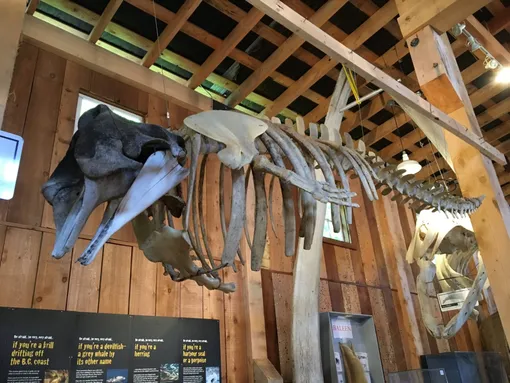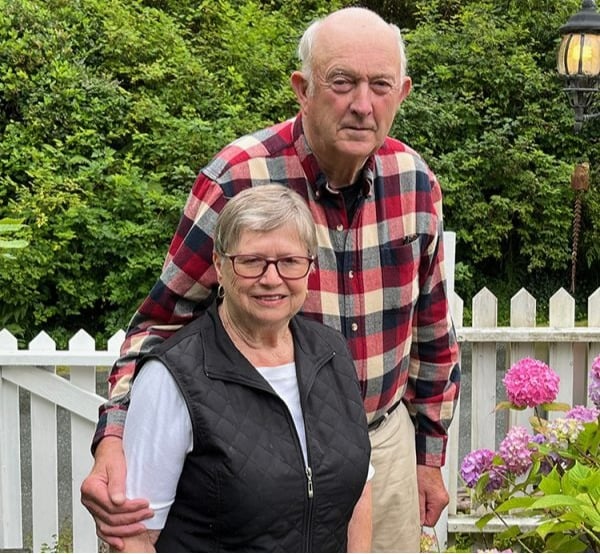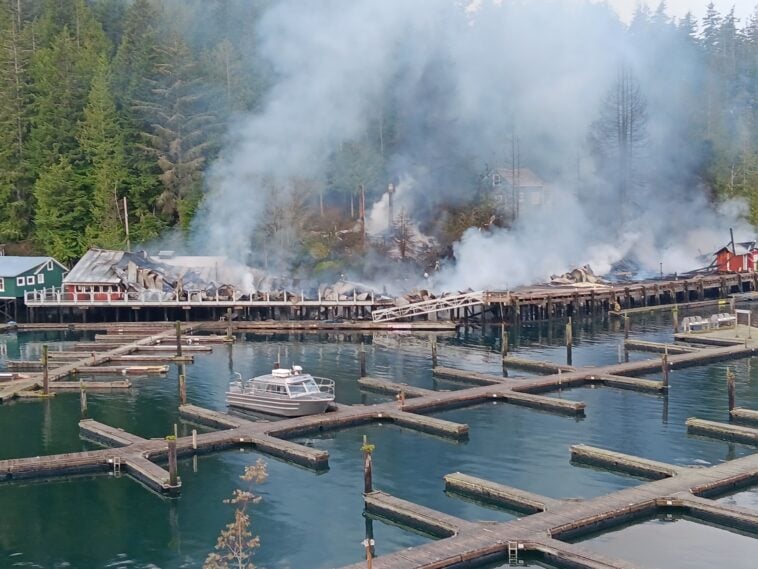On December 31, 2024, a fire tore through Telegraph Cove, a historic village on northern Vancouver Island near Port McNeill, causing significant damage that has profoundly impacted the community. This small but remarkable spot—a haven for sustainable tourism and marine conservation—lost several of its most treasured landmarks, including the Whale Interpretive Centre, the Old Saltery Pub and Killer Whale Café, the Wastell Manor heritage house, Prince of Whales offices and staff housing, as well as a portion of its famous boardwalk.
Beyond the physical loss, the fire has cast a shadow over the livelihoods of those who relied on the village’s thriving tourism, which is the basis of Telegraph Cove’s economy. In fact, the picturesque village with only about 20 year-round residents hosts around 120,000 visitors annually, a boon for not only Telegraph Cove but the surrounding communities as well.
“For our area, we’re not just losing the first time visitors, we get a lot of repeat visitors to the area and that impacts not just the Cove but Port Hardy, Port McNeill, Alert Bay, Sointula, there’s a spin off for everybody so the economic impact will be significant.”
Port McNeill Town Councillor Shelley Downey
Loss of a Treasure: The Whale Interpretive Centre
The world-renowned Whale Interpretive Centre offered an unparalleled educational experience. Since its founding in 2002, the centre had become a vital stop for tourists and researchers alike, reinforcing Telegraph Cove’s reputation as a hub for marine stewardship. According to Telegraph Cove Resort, the centre alone receives 25,000 visitors annually.
David Summers, director of the Mount Waddington Regional District, said the loss of the Whale Interpretive Centre was a tremendous blow.
“That whale museum, I mean, it was spectacular. It had the skeletons of every kind of whale and sea mammal and sea lion… people come from all over the world to go there,” said Summers.
The centre was set up by Jim and Mary Borrowman. Jim collected marine mammal skeletons for over 45 years, with the goal to preserve them so they can be studied. His collection was the foundation of the museum’s trove of skeletons and specimens.
“There is very significant material loss, including The Whale Interpretive Centre with all its skeletons and importance for education/ conservation,” wrote Jackie Hildering, a whale expert known as The Marine Detective in a post on her Facebook page. None of the whale skeletons survived the fire, but Hildering said that there may have been bones that fell into the water, though retrieving them would be difficult and costly.

Economic Impact of the Fire
The fire’s destruction has sent economic shockwaves through the region. Telegraph Cove was not just a destination—it was an economic engine for northern Vancouver Island. Visitors spending money on accommodations, dining, and tours helped sustain local businesses and created ripple effects across the community. According to the Telegraph Cove website, 120,000 tourists visit annually.
“Telegraph Cove and the Whale Interpretive Centre are huge draws for the North Island and an very important part of our history and tourism economy,” said Natalie Stewart, Tourism Development Specialist for Vancouver Island North.
Based on tourist spending data from northern Vancouver Island, The Skeena estimates that these tourists contribute $18 million annually to the regional economy. Now, with most of the boardwalk and interpretive centre reduced to ashes, the livelihoods of workers, tour operators, and nearby suppliers hang in the balance. For many, the fire not only disrupts the peak tourism season but also raises questions about what comes next.
“For our area, we’re not just losing the first time visitors, we get a lot of repeat visitors to the area and that impacts not just the Cove but Port Hardy, Port McNeill, Alert Bay, Sointula, there’s a spin off for everybody so the economic impact will be significant,” Port McNeill Town Councillor Shelley Downey told CHEK News.
“My wife and I are nearing retirement. We are devastated to witness our life’s work, which I milled and built with my own hands, go up in flames.”
Gordie Graham, Telegraph Cove owner
The resort has previously seen guests like Oprah Winfrey, UK prime minister John Major, and George Bush Sr., all of whom came to view the wildlife.
Community Response
“My wife and I are nearing retirement. We are devastated to witness our life’s work, which I milled and built with my own hands, go up in flames,” said Gordie Graham, owner and founder of the resort. “While we are grateful that no one was harmed in the fire, we are experiencing one of our worst nightmares.”
Longtime Alert Bay resident Rob Campbell said the flames and smoke were visible from his community across the water from Telegraph Cove.

“It’s a horrific loss, all the antiques and heritage stuff that was lost in the museum [there] … It’s devastating for the folks down there,” he said.
From local residents to visitors from afar, support has poured in to help Telegraph Cove rebuild. Fundraising campaigns are already in motion, with businesses, conservation groups, and individuals pledging to assist. A GoFundMe campaign launched by one of the Grahams’ children has already raised almost $50,000 to date.
Emily Gatto, a former employee of the Whale Interpretive Centre, reflected on her personal connections tied to the facility.
“We’ve all put so much work into this collection over the years, building skeletons, fundraising, maintaining, educating,” she said.
Gatto now lives in nearby Port McNeill. The centre’s significance to her life extends beyond work; it’s where she met her husband in 2019 and where they got married in 2023.
The children of the Borrowmans, Laurel and Darren, also shared their thoughts on Facebook.
Laurel wrote that the resort and Whale Interpretive Centre “show how a very small community fuelled by deep respect for history and unwavering responsibility [can] educate people and preserve the natural history, ecosystems, and [wildlife] of Telegraph Cove on the North Island. The world can be a hard place to find good in. To me, Telegraph Cove was and is still proof that exists.”
“It took a long time for the vision to come to life and for over 20 years, the WIC was an incredible place for people to learn and experience the vision that Jim and everyone involved shared. He consistently worked in the background throughout the year to make it what was,” wrote Darren.
There was an outpouring of sympathy and support on the Whale Interpretive Centre’s Facebook page.
“The WIC is my favourite natural history museum in the world, and I expect that is true for many.”
Emily VanLidth de Jeude
“Personally, my life would be very different, had I not fallen so deeply in love with our territory, the [wildlife] and our natural environment,” wrote Ernest Alfred, crediting Telegraph Cove and the Whale Interpretive Centre for being sites of “emotional attachment and memories.”
“So fond of Telegraph Cove since my first visits in July 1973 and then watching the interpretive centre come together with Jim and Mary’s huge long-term effort,” wrote Erich Hoyt.
Another commenter, Emily VanLidth de Jeude, wrote that “The WIC is my favourite natural history museum in the world, and I expect that is true for many.”
Rebuilding Plans and a Hopeful Outlook
Despite the devastation, the Grahams, Borrowmans, and the Telegraph Cove community are determined to rebuild. Plans are already taking shape to restore key structures, including the Whale Interpretive Centre. The centre’s directors have set an ambitious $1 million fundraising goal to reconstruct the facility. The fundraiser is open to the public.
Meanwhile, efforts are underway to ensure the resort can welcome visitors for the upcoming tourist season. The focus is not just on rebuilding but on preserving Telegraph Cove’s essence as a place where history, nature, and community converge while continuing to have a positive impact on the local economy through sustainable tourism.
“We’re going to do our best [to rebuild], and we’ve got tremendous support, and I plan to live to be 100 now. I was only going to plan to be 85 but I’ll wait till I’m 100 to die so we can get this built.”
Jim Borrowman, Whale Interpretive Centre chairperson
“Telegraph Cove has always been a place of connection and renewal. While today we mourn, we also look to the future with hope. My phone is ringing steadily with messages of support and community members checking in on us. We appreciate every message,” said Marilyn Graham.
“As the sun rises on this new day and a brand-new year begins, let it be a reminder that each moment holds the potential for growth, change and new beginnings,” said Jim and Mary Borrowman in a Facebook post on The Whale Interpretive Centre’s Facebook page.
“We’re going to do our best [to rebuild], and we’ve got tremendous support, and I plan to live to be 100 now. I was only going to plan to be 85 but I’ll wait till I’m 100 to die so we can get this built,” Jim said.
As plans take shape to rebuild, the community is focused on ensuring that the village continues to be a place where people connect with the natural world and with each other. Telegraph Cove’s story has always been one of reinvention and perseverance, and this chapter will be no different. With determination and collective effort, the village is poised to emerge stronger, ready to inspire future generations with its enduring spirit and beauty.





